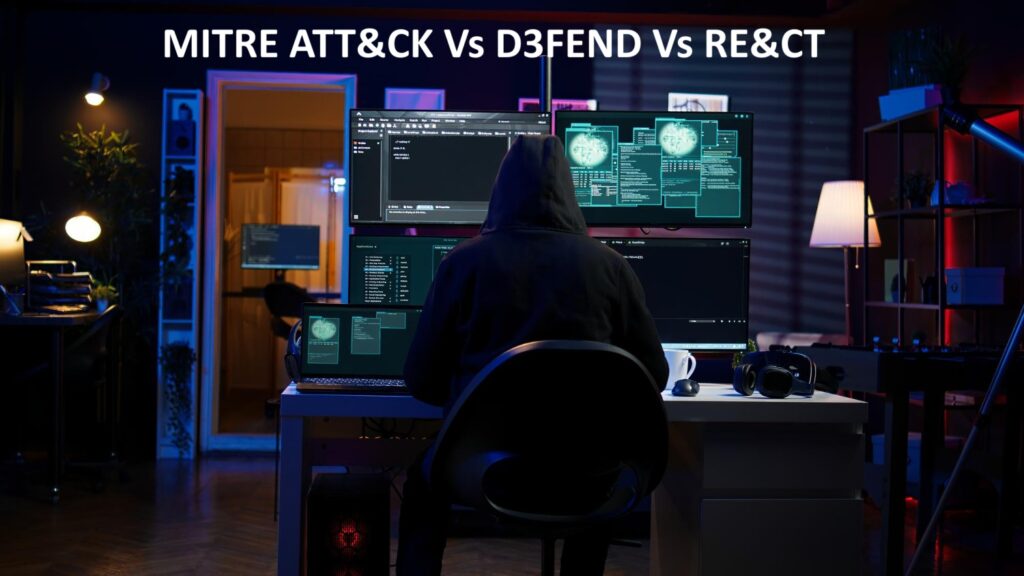
Status: Executive Summary
Author: Shahab Al Yamin Chawdhury
Organization: Principal Architect & Consultant Group
Research Date: 2025-07-28
Version: 1.0 Summary
The Strategic Imperative: A Unified Defense Model
Modern cybersecurity requires a shift from siloed, reactive functions to a proactive, integrated, and threat-informed defense. The strategic unification of three key frameworks provides a comprehensive model for achieving this:
- MITRE ATT&CK® (The “What”): Defines adversary behavior by cataloging their Tactics, Techniques, and Procedures (TTPs). It answers: “What are we up against?”
- MITRE D3FEND™ (The “How”): Provides a standardized vocabulary of defensive countermeasures that directly map to ATT&CK techniques. It answers: “How do we design our shield?”
- RE&CT (The “Now What?”): Scripts the actionable incident response procedures to execute when a defense is bypassed. It answers: “What do we do when an attack happens?”
Together, they form a continuous Security Operations Cycle: Threat intelligence (ATT&CK) informs defensive architecture (D3FEND), and the failure of a defense triggers a structured response (RE&CT), with lessons learned feeding back to improve defenses.
Key Findings & Strategic Recommendations
- Finding 1: Symbiotic Relationship: The frameworks are not competitive but operate in a logical sequence (ATT&CK -> D3FEND -> RE&CT).
- Finding 2: “Digital Artifact” as the Lynchpin: D3FEND uses the “Digital Artifact” (e.g., a process, a file) as the pivot to logically connect offensive ATT&CK techniques to defensive D3FEND countermeasures.
- Finding 3: Enables Data-Driven Prioritization: The unified model allows organizations to focus security investments on the most prevalent threats.
- Recommendation 1: Break Down Silos: Formally adopt the unified model to foster collaboration between Threat Intelligence (ATT&CK), Security Architecture (D3FEND), and SOC/IR (RE&CT) teams.
- Recommendation 2: Align Technology Investment: Evaluate and select security tools based on their explicit ability to provide telemetry and enforce controls defined by this integrated model.
Frameworks at a Glance
| Characteristic | MITRE ATT&CK | MITRE D3FEND | RE&CT |
| Primary Goal | Catalog adversary behavior. | Standardize defensive countermeasures. | Categorize actionable IR techniques. |
| Core Unit | Tactics, Techniques, Procedures (TTPs). | Defensive Techniques, Digital Artifacts. | Response Stages, Response Actions. |
| Primary Audience | Threat Intel, Red Teams, SOCs. | Security Architects, Systems Engineers. | SOC Analysts, IR Teams. |
| Key Verb | Describe (the attack) | Defend (the asset) | Respond (to the incident) |
Data-Driven Prioritization: Top Threats & Actions
Security efforts must be focused on the most probable threats. The following matrix links the most prevalent adversary techniques (based on 2023-2024 threat intelligence) to their corresponding defensive and responsive actions, providing a clear roadmap for resource allocation.
TTP Prevalence and Prioritization Matrix (Abbreviated)
| Rank | ATT&CK Technique (ID & Name) | Prevalence Score (1-10) | Primary D3FEND Countermeasures (ID) | Key RE&CT Response Actions (ID) |
| 1 | T1059.001 – PowerShell | 9.8 | D3-PA (Process Analysis), D3-EAL (Executable Allowlisting) | RA2401 (List running processes), RA4401 (Kill process) |
| 2 | T1078 – Valid Accounts | 9.5 | D3-UGLPA (User Geolocation Logon Pattern Analysis), D3-MFA | RA2602 (List authenticated users), RA3602 (Lock user account) |
| 3 | T1055 – Process Injection | 9.2 | D3-PCSV (Process Code Segment Verification), D3-PA | RA2404 (Analyze process memory), RA4401 (Kill process) |
| 4 | T1555 – Credentials from Stores | 8.9 | D3-UAP (User Account Permissions), D3-ACH (App Config Hardening) | RA2305 (Find file by content), RA4601 (Revoke credentials) |
| 5 | T1071 – Application Layer Protocol | 8.7 | D3-NTA (Network Traffic Analysis), D3-OTF (Outbound Traffic Filtering) | RA2101 (List external connections), RA3101 (Block IP) |
Strategic C-Suite Recommendations
- Justify Investment with Data: Use the prioritization matrix to anchor budget requests to specific, high-probability business risks. Frame investments as direct mitigations for known adversary techniques targeting your sector.
- Measure Program Effectiveness: Shift metrics from operational outputs to strategic outcomes. Report on:
- Defensive Coverage: The percentage of prevalent ATT&CK techniques covered by D3FEND controls.
- Response Capability: The percentage of high-priority threats with a documented and tested RE&CT playbook.
- Communicate in Business Terms: Structure reports to the board around the unified model:
- The Threat (ATT&CK): “Here are the top adversary techniques targeting our industry.”
- Our Defenses (D3FEND): “We have coverage for X of Y threats. Here is our plan to close the gap.”
- Our Response (RE&CT): “We have tested playbooks for these scenarios, reducing our potential incident impact.”
This approach transforms cybersecurity from a technical cost center into a strategic risk management partner, clearly articulating its value in protecting and enabling the business.